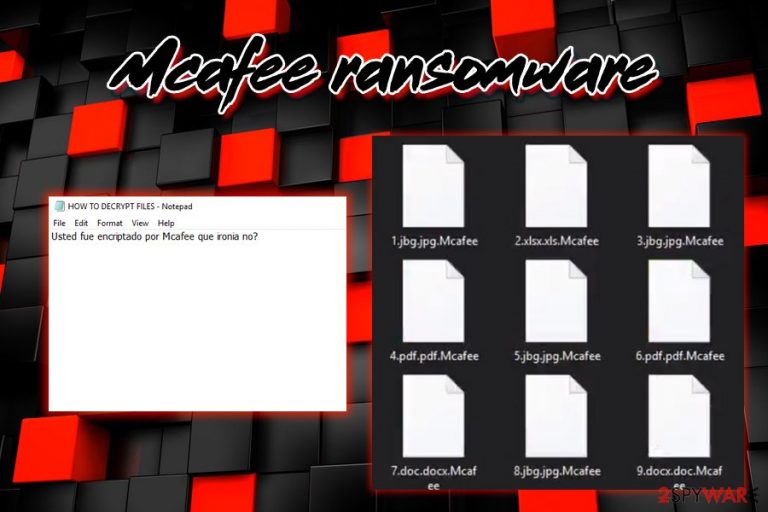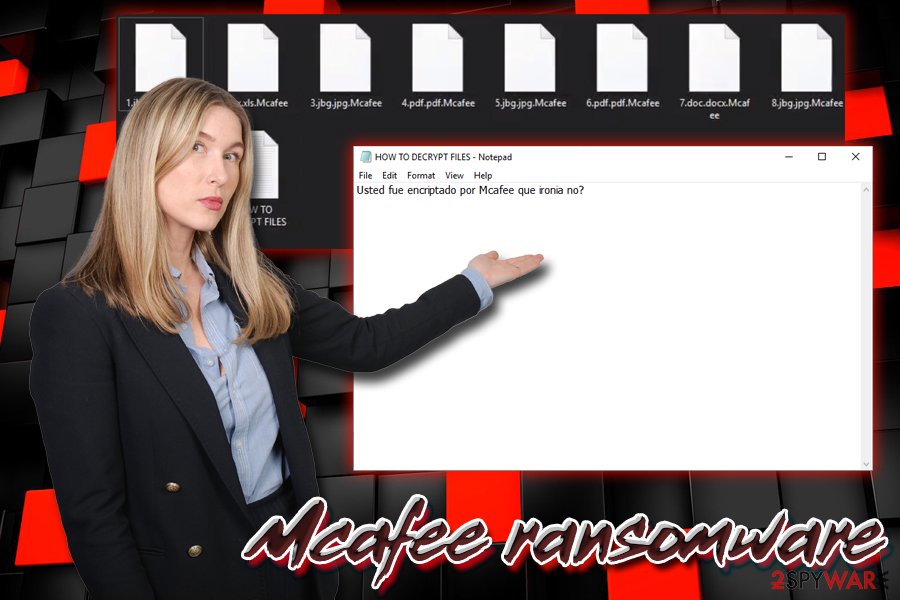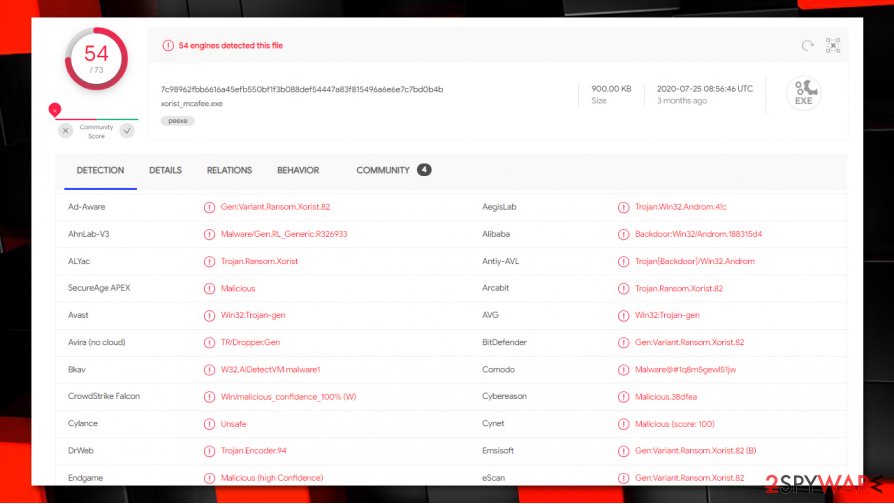Mcafee ransomware (Virus Removal Instructions) - Bonus: Decryption Steps
Mcafee virus Removal Guide
What is Mcafee ransomware?
Mcafee ransomware is a file locking virus that has nothing to do with the global computer security software company

Mcafee ransomware is a data-locking computer infection that specializes in money extortion. Despite its name being copied from the prominent security solution maker, the virus has nothing to do with the company and instead stems from an established malware family known as Xorist ransomware. Other versions include ZaLtOn, ZoNiSoNaL, and PAY IN 24 HOURS.
Malware uses the RSA encryption algorithm to encode data and then appends .Mcafee file extension, preventing users from accessing it. Documents, pictures, videos, and other personal files are affected – threat actors choose these file types to make a significant impact and make victims pay the ransom, which is demanded in the ransom note HOW TO DECRYPT FILES.txt.
The note, which is written in Spanish (which could mean that the attacks are localized or that the developers are Spanish speakers), is mocking victims, claiming that it is ironic that Mcafee virus has locked their all personal files. No contact details or the ransom size is not provided, so there is a chance that the decryption tool could be retrieved from the malicious actors.
| Name | Mcafee ransomware / Mcafee virus / .Mcafee file virus |
| Type | Ransomware |
| Variant of | Xorist ransomware |
| Main executable | Xorist.exe, Mcafee.exe |
| First discovered | Jan 30, 2019 |
| Cipher used | RSA |
| Ransom note | HOW TO DECRYPT FILES.txt |
| Contact | None |
| Decryptable? | No |
| Removal | Use security software that can detect the threat. If required, access Safe Mode with Networking – we provide the instructions below |
| System fix | In case your computer starts crashing, lagging, or returning errors after you get rid of the infection, use FortectIntego to restore system files to the original state and fix virus damage automatically |
Mcafee ransomware virus is most likely distributed in a variety of ways, including spam email attachments, weak RDP configuration, fake updates, exploits, cracks or keygens, and similar. To prevent being infected with malware and avoid virus damage as well as lost files, refer to the second section.
But first, you have to remove Mcafee ransomware virus from your PC using security software that can detect[1] the threat – we recommend using SpyHunter 5Combo Cleaner or Malwarebytes. Additionally, FortectIntego software is capable of repairing the damage done to the computer system files, which prevents crashes and other issues post-infection.
Before Mcafee virus encrypts data, it performs various changes to the system, including Windows Registry modification, import of files, shutting down of various system processes, etc. Once complete, malware begins a scan to locate all the data that uses a list of extensions that are predetermined by Mcafee ransomware authors.
Once locked, data becomes inaccessible and .Mcafee extension is added to each of the files. The ransom note states the following:
Usted fue encriptado por Mcafee que ironia no?
Which, translated from Spanish means “Mcafee encrypted your files is it not ironic?.” While virus authors try to be whimsical, this situation is anything but funny for the victims, as their files are in danger.

Mcafee virus is not decryptable currently, and there is no way to contact criminals either (although industry experts[2] generally discourage people from paying the ransom). Therefore, if you got infected, you should first perform Mcafee ransomware removal, and then either use backups or third-party data recovery software – we provide all the instructions below.
.Mcafee file recovery options
As evident, the safest and best way of recovering from a ransomware attack is by restoring data from backups. Unfortunately, most users who get infected with ransomware have never dealt with this type of computer infection before and never prepared by creating effective backups. Inexperience within the IT field is also the reason why many users believe that anti-malware software can return the locked files back to normal – it is far from the truth, as data remains encrypted even after malware is deleted fully.
So, many of you might be asking how to recover .Mcafee files without backups. Unfortunately, the answer is not that simple. As soon as the encryption process is deployed, data is encrypted with a strong encryption algorithm, which means that the “password” needed to unlock files is unique and only accessible to the attackers.
No specific software exists that could remove .Mcafee extension and make the data accessible again. However, there are a few alternatives that might just be able to help you in some cases. Below is our recovery section, you will find a few tips on how to restore encrypted data there, although keep in mind that malware needs to fail to delete Shadow Copies from your Windows system for these methods to work.

Do not get tricked by cybercriminals – be attentive online
Hackers who create ransomware viruses are usually sophisticated people (although some malware can be used as Ransomware-as-a-service[3] – then anybody can employ the malicious code for money extortion). Therefore, they use various tricks to make victims install the payload. The most commonly used tactic is phishing, although more sophisticated options like brute-forcing and software vulnerabilities are also used.
Therefore, follow this guide to reduce the possibility of ransomware infection:
- Use strong passwords for all your accounts (do not reuse it!) and employ VPN when using RDP;
- Patch your system and installed software as soon as updates are released;
- Download updates and software from reputable sources only and avoid third-party sites;
- Disable Adobe Flash;
- Run a reputable anti-malware solution;
- Be very cautious when opening emails from unknown sources. The included attachments or hyperlinks can lead to ransomware infection;
- Do not click on suspicious links or explore websites you were redirected to.
Remove Mcafee ransomware with the help of security application
Mcafee ransomware removal should not be a complicated task, as long as you follow our instructions below and use sufficient security software (such as SpyHunter 5Combo Cleaner or Malwarebytes) that could locate all the malicious files that the virus created and eliminate them. To make sure that Mcafee virus does not interfere with the operation of the anti-malware program, enter Safe Mode with Networking – it is a safe environment that loads the system on with the most necessary drivers.
Once you remove Mcafee ransomware from your device, try the programs listed below for file decryption. The chances of recovering data in such a way is quite low, but not impossible. Finally, if you are not successful, make a copy of databases, pictures, videos, documents, and other files because security researchers might develop an official decryptor one day. Note: if you experience crashes or other system stability issues, try to fix virus damage with FortectIntego instead of reinstalling Windows.
Getting rid of Mcafee virus. Follow these steps
Manual removal using Safe Mode
To remove Mcafee ransomware safely, reach Safe Mode with Networking as explained below:
Important! →
Manual removal guide might be too complicated for regular computer users. It requires advanced IT knowledge to be performed correctly (if vital system files are removed or damaged, it might result in full Windows compromise), and it also might take hours to complete. Therefore, we highly advise using the automatic method provided above instead.
Step 1. Access Safe Mode with Networking
Manual malware removal should be best performed in the Safe Mode environment.
Windows 7 / Vista / XP
- Click Start > Shutdown > Restart > OK.
- When your computer becomes active, start pressing F8 button (if that does not work, try F2, F12, Del, etc. – it all depends on your motherboard model) multiple times until you see the Advanced Boot Options window.
- Select Safe Mode with Networking from the list.

Windows 10 / Windows 8
- Right-click on Start button and select Settings.

- Scroll down to pick Update & Security.

- On the left side of the window, pick Recovery.
- Now scroll down to find Advanced Startup section.
- Click Restart now.

- Select Troubleshoot.

- Go to Advanced options.

- Select Startup Settings.

- Press Restart.
- Now press 5 or click 5) Enable Safe Mode with Networking.

Step 2. Shut down suspicious processes
Windows Task Manager is a useful tool that shows all the processes running in the background. If malware is running a process, you need to shut it down:
- Press Ctrl + Shift + Esc on your keyboard to open Windows Task Manager.
- Click on More details.

- Scroll down to Background processes section, and look for anything suspicious.
- Right-click and select Open file location.

- Go back to the process, right-click and pick End Task.

- Delete the contents of the malicious folder.
Step 3. Check program Startup
- Press Ctrl + Shift + Esc on your keyboard to open Windows Task Manager.
- Go to Startup tab.
- Right-click on the suspicious program and pick Disable.

Step 4. Delete virus files
Malware-related files can be found in various places within your computer. Here are instructions that could help you find them:
- Type in Disk Cleanup in Windows search and press Enter.

- Select the drive you want to clean (C: is your main drive by default and is likely to be the one that has malicious files in).
- Scroll through the Files to delete list and select the following:
Temporary Internet Files
Downloads
Recycle Bin
Temporary files - Pick Clean up system files.

- You can also look for other malicious files hidden in the following folders (type these entries in Windows Search and press Enter):
%AppData%
%LocalAppData%
%ProgramData%
%WinDir%
After you are finished, reboot the PC in normal mode.
Remove Mcafee using System Restore
System Restore is another way to get rid of malware:
-
Step 1: Reboot your computer to Safe Mode with Command Prompt
Windows 7 / Vista / XP- Click Start → Shutdown → Restart → OK.
- When your computer becomes active, start pressing F8 multiple times until you see the Advanced Boot Options window.
-
Select Command Prompt from the list

Windows 10 / Windows 8- Press the Power button at the Windows login screen. Now press and hold Shift, which is on your keyboard, and click Restart..
- Now select Troubleshoot → Advanced options → Startup Settings and finally press Restart.
-
Once your computer becomes active, select Enable Safe Mode with Command Prompt in Startup Settings window.

-
Step 2: Restore your system files and settings
-
Once the Command Prompt window shows up, enter cd restore and click Enter.

-
Now type rstrui.exe and press Enter again..

-
When a new window shows up, click Next and select your restore point that is prior the infiltration of Mcafee. After doing that, click Next.


-
Now click Yes to start system restore.

-
Once the Command Prompt window shows up, enter cd restore and click Enter.
Bonus: Recover your data
Guide which is presented above is supposed to help you remove Mcafee from your computer. To recover your encrypted files, we recommend using a detailed guide prepared by 2-spyware.com security experts.Data recovery is not possible unless you have backups. However, there is a chance to restore at least some of your files with the help of third-party software or a few other methods.
If your files are encrypted by Mcafee, you can use several methods to restore them:
Rely on Data Recovery Pro to get your files back
Data Recovery Pro is professional software that is capable of restoring a variety of files. Nevertheless, it has seen some success with ransomware encrypted files, so try it out.
- Download Data Recovery Pro;
- Follow the steps of Data Recovery Setup and install the program on your computer;
- Launch it and scan your computer for files encrypted by Mcafee ransomware;
- Restore them.
Recover some of your files using Windows Previous Versions
This method may help you restore each file individually. However, it only works if you had System Restore enabled before ransomware struck.
- Find an encrypted file you need to restore and right-click on it;
- Select “Properties” and go to “Previous versions” tab;
- Here, check each of available copies of the file in “Folder versions”. You should select the version you want to recover and click “Restore”.
Take advantage of ShadowExplorer
ShadowExplorer is a program that can recover all your files if Shadow Volume Snapshots were untouched by Mcafee ransomware.
- Download Shadow Explorer (http://shadowexplorer.com/);
- Follow a Shadow Explorer Setup Wizard and install this application on your computer;
- Launch the program and go through the drop down menu on the top left corner to select the disk of your encrypted data. Check what folders are there;
- Right-click on the folder you want to restore and select “Export”. You can also select where you want it to be stored.
No decryptor is available yet
Finally, you should always think about the protection of crypto-ransomwares. In order to protect your computer from Mcafee and other ransomwares, use a reputable anti-spyware, such as FortectIntego, SpyHunter 5Combo Cleaner or Malwarebytes
How to prevent from getting ransomware
Choose a proper web browser and improve your safety with a VPN tool
Online spying has got momentum in recent years and people are getting more and more interested in how to protect their privacy online. One of the basic means to add a layer of security – choose the most private and secure web browser. Although web browsers can't grant full privacy protection and security, some of them are much better at sandboxing, HTTPS upgrading, active content blocking, tracking blocking, phishing protection, and similar privacy-oriented features. However, if you want true anonymity, we suggest you employ a powerful Private Internet Access VPN – it can encrypt all the traffic that comes and goes out of your computer, preventing tracking completely.
Lost your files? Use data recovery software
While some files located on any computer are replaceable or useless, others can be extremely valuable. Family photos, work documents, school projects – these are types of files that we don't want to lose. Unfortunately, there are many ways how unexpected data loss can occur: power cuts, Blue Screen of Death errors, hardware failures, crypto-malware attack, or even accidental deletion.
To ensure that all the files remain intact, you should prepare regular data backups. You can choose cloud-based or physical copies you could restore from later in case of a disaster. If your backups were lost as well or you never bothered to prepare any, Data Recovery Pro can be your only hope to retrieve your invaluable files.
- ^ 7c98962fbb6616a45efb550bf1f3b088def54447a83f815496a6e6e7c7bd0b4b. Virus Total. File and URL analysis.
- ^ Virusi. Virusi. Cybersecurity experts.
- ^ Ransomware-as-a-Service (RaaS): How It Works. Tripwire. Cyber Security Solutions With Foundational Controls.







